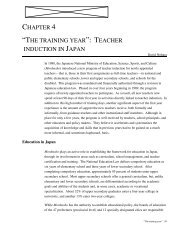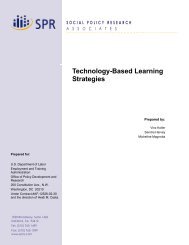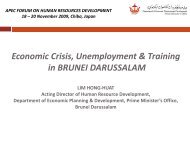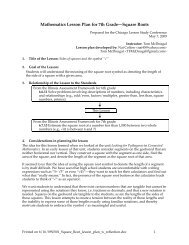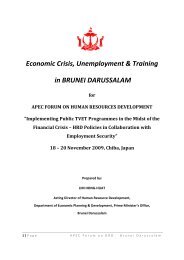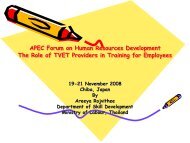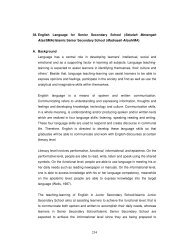Quality Assurance Systems in Asia-Pacific Economic Cooperation
Quality Assurance Systems in Asia-Pacific Economic Cooperation
Quality Assurance Systems in Asia-Pacific Economic Cooperation
You also want an ePaper? Increase the reach of your titles
YUMPU automatically turns print PDFs into web optimized ePapers that Google loves.
ENHANCEMENT OF QUALITY ASSURANCE SYSTEMS IN HIGHER EDUCATION IN APEC MEMBER ECONOMIES<br />
6. Outcomes and Implications of the QA<br />
Processes<br />
An external QA system is a significant undertak<strong>in</strong>g for any government and its HE sector, <strong>in</strong><br />
terms of time, cost and consequences. This is why, as described above, close attention is<br />
paid to the structure and plann<strong>in</strong>g of the QA processes. It is also why QA decisions must be<br />
reported appropriately, and why the processes should have positive effects. We turn now to<br />
these aspects of the QA process.<br />
6.1 Report<strong>in</strong>g the Outcome<br />
The quality assurance outcomes by the agency is a crucial element <strong>in</strong> the eventual impact of<br />
the quality assurance processes. When the purpose of quality assurance is to certify whether<br />
an <strong>in</strong>stitution (or program) qualifies for a certa<strong>in</strong> status such as recognition as an <strong>in</strong>stitution of<br />
higher learn<strong>in</strong>g or approval for offer<strong>in</strong>g degree-grant<strong>in</strong>g programs or eligibility for public<br />
fund<strong>in</strong>g, the outcome may be a simple yes/no or accredited/not-accredited. This is the<br />
outcome of most licens<strong>in</strong>g and accreditation models. Some agencies declare this formal<br />
status only.<br />
When quality assurance is expected to check a threshold level of quality or when the quality<br />
assurance outcome is used for simple decisions, the b<strong>in</strong>ary scale outcome aga<strong>in</strong> serves the<br />
purpose. The two-po<strong>in</strong>t scale (Accredited/Not accredited) is generally found <strong>in</strong> systems where<br />
quality assurance serves the purpose of regulation or approval or recognition. It states<br />
whether the <strong>in</strong>stitution or program meets basic conditions, but it is unable to recognise<br />
different levels of quality among those that do.<br />
Some agencies provide the f<strong>in</strong>al outcome on a multi-po<strong>in</strong>t scale. If the quality assurance<br />
exercise asks: “how good are your outputs?” the typical outcome of such an exercise would<br />
be <strong>in</strong> a multi-po<strong>in</strong>t grade - numeric or literal or descriptive. This would be suitable if the quality<br />
assurance agency wishes to focus on outcomes and levels of atta<strong>in</strong>ment. For example, if the<br />
quality assurance outcome is to be used by the government or fund<strong>in</strong>g body to decide the<br />
fund<strong>in</strong>g levels, the b<strong>in</strong>ary state of accreditation outcome may not be enough. In such cases,<br />
the agency might opt for assessment where the levels of quality are expressed on a multipo<strong>in</strong>t<br />
scale. Large systems with a lot of variation <strong>in</strong> quality might opt for the multi-po<strong>in</strong>t<br />
outcome. The accredit<strong>in</strong>g agencies of Philipp<strong>in</strong>es state that “Due to the variations of quality, it<br />
was decided to offer accreditation at four different levels, each entail<strong>in</strong>g specific benefits both<br />
<strong>in</strong> terms of adm<strong>in</strong>istrative autonomy and access to <strong>in</strong>centive funds. The higher the level of<br />
accreditation, the more the autonomy granted to the <strong>in</strong>stitution.”<br />
A different way of implement<strong>in</strong>g a ‘multi-po<strong>in</strong>t scale’ is to use a b<strong>in</strong>ary decision (accredited/not<br />
accredited) but specify different durations for the accredited status. This may be a good way<br />
of deal<strong>in</strong>g with diverse <strong>in</strong>stitutions. If they are perceived to be reliable, and to be able to<br />
ensure the quality of their work, accreditation may last for a longer period of time (5 to 10<br />
years). If, on the other hand, they need closer supervision, they may be accredited for as little<br />
as two to three years. This is <strong>in</strong> practice <strong>in</strong> the US among the regional accreditors. In Chile<br />
the QA outcome is valid for a period between one and seven years.<br />
Some QA activities result <strong>in</strong> reports only. If the quality assurance exercise is clearly focused<br />
on the processes by which an <strong>in</strong>stitution monitors its own academic standards and acts to<br />
assure and enhance the quality of its offer<strong>in</strong>gs, it might result <strong>in</strong> a report, as <strong>in</strong> the case of a<br />
typical quality audit. The objectives of the <strong>in</strong>stitution or program are taken as the start<strong>in</strong>g po<strong>in</strong>t<br />
for the audit and the audit report expla<strong>in</strong>s how successful the <strong>in</strong>stitution is <strong>in</strong> try<strong>in</strong>g to meet its<br />
stated objectives by plac<strong>in</strong>g appropriate processes <strong>in</strong> place. Due to the emphasis on <strong>in</strong>ternal<br />
processes of the <strong>in</strong>stitution or program, this method might be more useful for mature systems<br />
with well-established <strong>in</strong>ternal processes. <strong>Systems</strong> that <strong>in</strong>tend to strengthen their <strong>in</strong>ternal<br />
processes for quality may also benefit from this.<br />
In practice, a quality assurance system may use a comb<strong>in</strong>ation of the above. Choos<strong>in</strong>g an<br />
option for the report<strong>in</strong>g strategy is not as simple and straightforward as has been presented<br />
23



